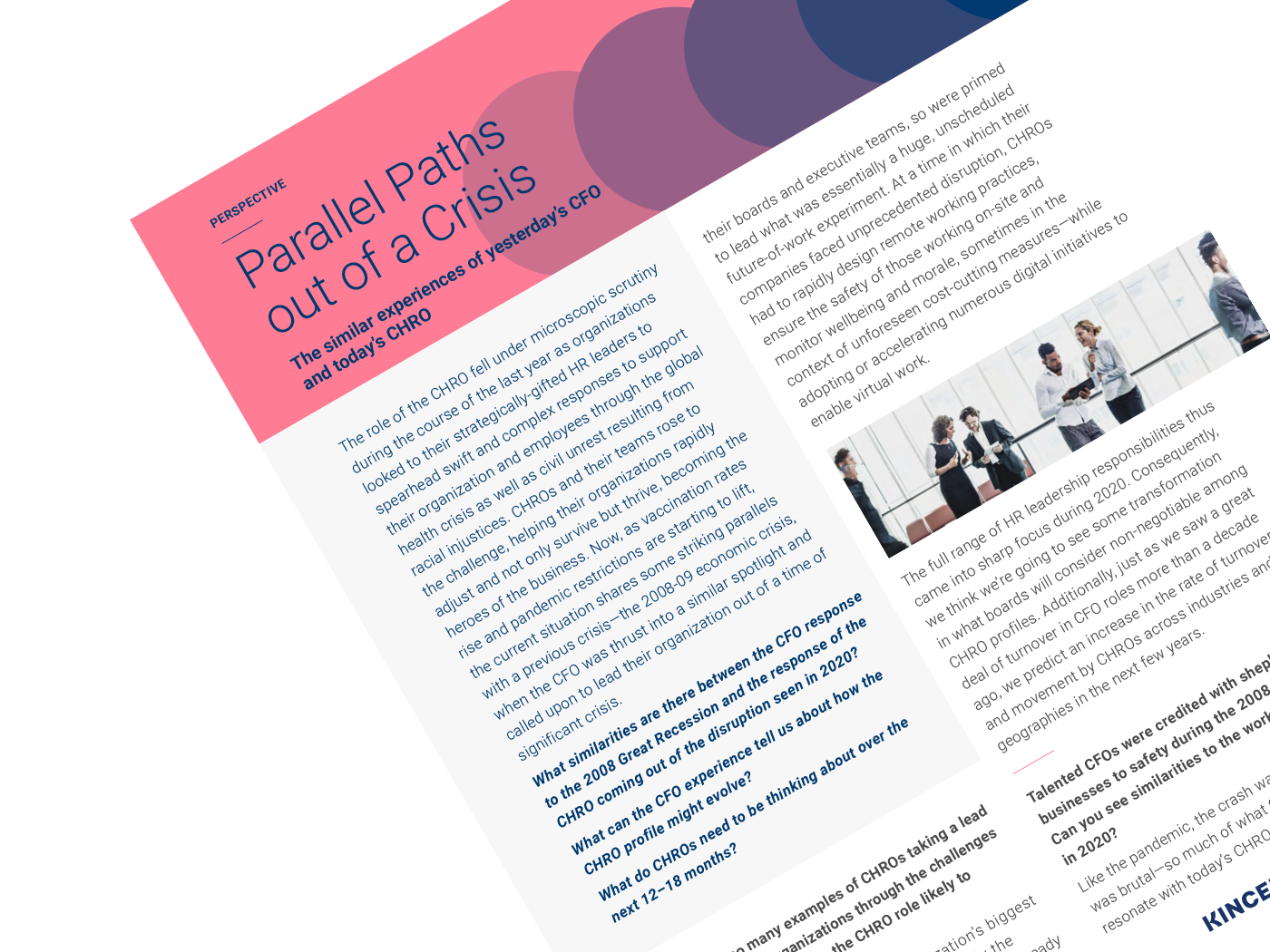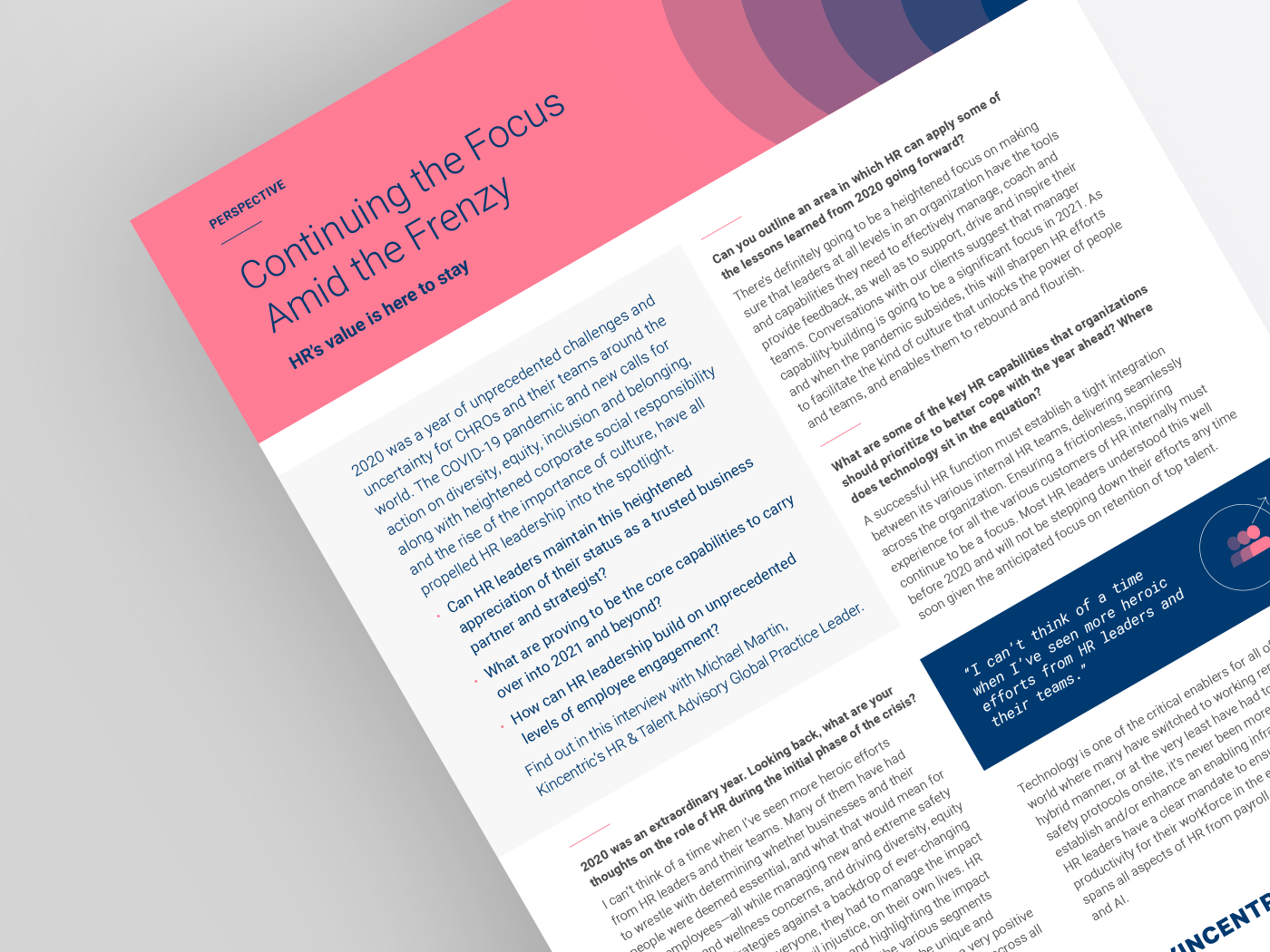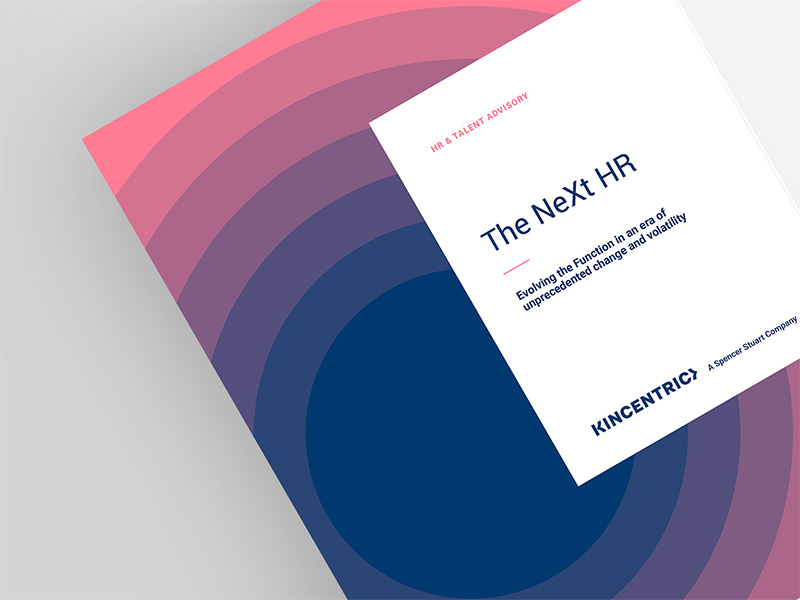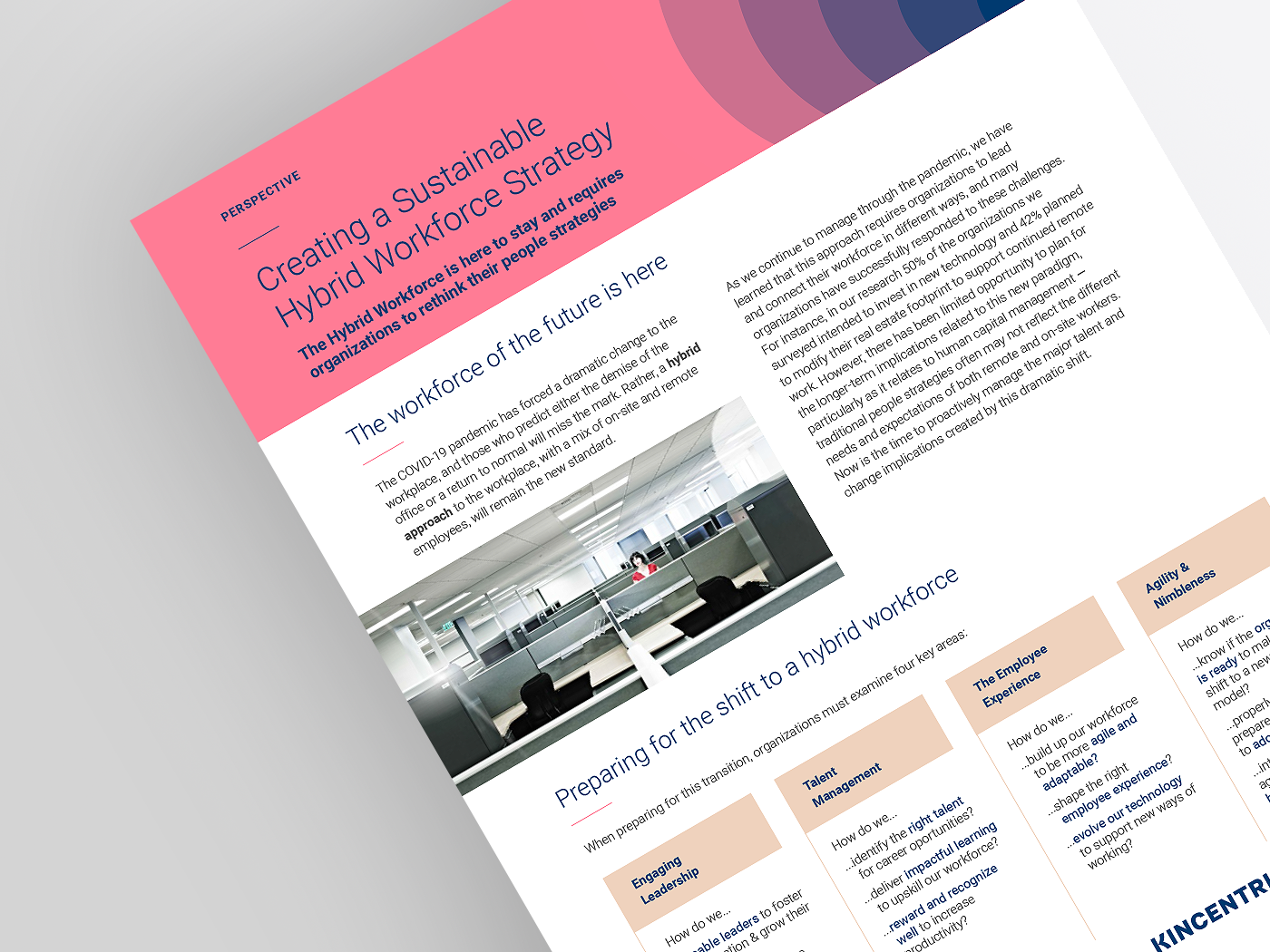
The role of the CHRO fell under microscopic scrutiny during the course of the last year as organizations looked to their strategically-gifted HR leaders to spearhead swift and complex responses to support their organization and employees through the global health crisis as well as civil unrest resulting from racial injustices. CHROs and their teams rose to the challenge, helping their organizations rapidly adjust and not only survive but thrive, becoming the heroes of the business. Now, as vaccination rates rise and pandemic restrictions are starting to lift, the current situation shares some striking parallels with a previous crisis—the 2008-09 economic crisis, when the CFO was thrust into a similar spotlight and called upon to lead their organization out of a time of significant crisis.
What similarities are there between the CFO response to the 2008 Great Recession and the response of the CHRO coming out of the disruption seen in 2020?
What can the CFO experience tell us about how the CHRO profile might evolve?
What do CHROs need to be thinking about over the next 12–18 months?
Learn more in this interview.
We’ve seen so many examples of CHROs taking a lead in steering their organizations through the challenges of the last 18 months. Is the CHRO role likely to change or evolve as a result?
The pandemic hit hard every organization’s biggest asset—their people—and they’re obviously the raison d’être of HR. Successful CHROs were already closely connected as strategic business partners to their boards and executive teams, so were primed to lead what was essentially a huge, unscheduled future-of-work experiment. At a time in which their companies faced unprecedented disruption, CHROs had to rapidly design remote working practices, ensure the safety of those working on-site and monitor wellbeing and morale, sometimes in the context of unforeseen cost-cutting measures—while adopting or accelerating numerous digital initiatives to enable virtual work.
The full range of HR leadership responsibilities thus came into sharp focus during 2020. Consequently, we think we’re going to see some transformation in what boards will consider non-negotiable among CHRO profiles. Additionally, just as we saw a great deal of turnover in CFO roles more than a decade ago, we predict an increase in the rate of turnover and movement by CHROs across industries and geographies in the next few years.
Talented CFOs were credited with shepherding businesses to safety during the 2008 financial crisis. Can you see similarities to the work done by CHROs in 2020?
Like the pandemic, the crash was as fast as it was brutal—so much of what CFOs underwent will resonate with today’s CHROs. The strategic importance of the CFO role had already been expanding when the financial crisis erupted. This was in the wake of previous fiscal emergencies, such as the Enron scandal, which prompted stringent measures—notably the U.S.’s 2002 Sarbanes-Oxley Act—to stamp out fraudulent financial reporting practices.
As financial and banking institutions collapsed, successful CFOs became the linchpins within many organizations, working closely with the CIO and CHRO to deploy new technologies and processes to maintain stability and order. Amid the turmoil, CFOs had to also identify new and prudent means of financing that were capable of weathering the storm, and risk and compliance became burning issues for boards, CEOs and shareholders.
Surviving the 2008 crisis depended on nimble yet nuanced responses and collaboration across the C-Suite, something today’s CHRO will recognize. Over the course of 2020 and into 2021, many CHROs found themselves thrust into the hot seat, taking the lead in resetting strategy, deploying new technologies and spearheading the adoption of new ways of working, all the while ensuring employees felt safe and supported emotionally and physically in the midst of internal organizational change and external environmental unrest. And similar to the shift we saw in the CFO role, we predict the role of the CHRO will continue to evolve, earning them a more pronounced and permanent role as an enterprise leader.
There was a big push to increase automation in the wake of the 2008 fiscal crisis. How does that compare with the post-pandemic HR function?
Postcrash, the urgent need to manage costs and improve efficiency prompted a large-scale digital transformation of the entire finance function. Investment in automation and digital finance as well as a movement towards shared services was rapid, and part of a concerted effort to embed quality and process improvements. Critically, it was also tightly linked to mitigating litigation risks because the CFO role was shifting toward being more accountable for risk management, not just finance. CFOs continued to drive operational transformation as part of their increasing strategic involvement.We’re seeing the same trend in HR. Ensuring a great employee experience (eX) in a hybrid or remote environment requires robust HRIS systems and HR technologies, providing employees and managers with a seamless and efficient way to manage foundational HR activities such as payroll, benefits and the like. The digital transformation of HR also creates capacity for HR leaders to focus on supporting and enabling the business. As enterprise digital transformations continue, it is also incumbent on HR to create the right organizational design as well as redefine roles, capabilities and talent management processes that align with evolving business strategy.
There was a concerted industry push around organizational financial literacy after the crash. What’s the equivalent for CHROs?
After 2008 there was a realization that fiscal literacy was important throughout the organization, and not reserved solely for the finance team; a lot of work went into building financial acumen across the enterprise. Today we’re seeing the same understanding around the importance of DE&I, and for CHROs, working in concert with their C-Suite peers, the focus will be around how to infuse DE&I more broadly throughout the organization, starting with creating a comprehensive DE&I strategy, aligning executive leadership and building manager capability. This will more than likely require an examination of current talent management, recruitment and retention strategies to ensure they are fair and equitable to all.
We’re also observing a growing understanding around well-being—that it’s not just HR’s job to take care of well-being or wellness—but rather it needs to be owned by everybody—particularly first-line managers. Thus, for CHROs, literacy around DE&I and wellness are key factors in nourishing the employee eXperience and driving organizational effectiveness moving forward.
Finally, as we continue to manage through the pandemic, research shows that more and more people are going to be looking to change jobs, so there must be a focus on retaining talent and on astute succession and development planning. Developing a comprehensive Talent strategy alongside paying attention to employees’ development and careers goes a long way to securing—and retaining—the right people.
What should CHROs concentrate on as we move out of the crisis?
As the frenzy starts to fade, CHROs must continue to focus on new ways of working—everything from roles, workflows, office location and design, policies and procedures to technology and strategy. The disruption over the course of the last year and a half has created a virtual laundry list of focus areas for the CHRO—the return to the workplace, be it on-site, remote, or a combination of the two; DE&I initiatives; employee health, safety and wellness; automation and digital transformation; talent management; culture and engagement; recruiting and retention—the list is virtually endless. Therefore, it is imperative that the CHRO set priorities that are aligned with the most critical organizational and business needs. They need to work in concert with the CEO, CIO and CFO to determine where to invest time, talent and resources to achieve quick wins as well as lasting returns. Once identified, shifting strategies and priorities must be clearly articulated and communicated throughout the organization, with guiding principles and processes around which the enterprise can align.
While some employee populations may fully return to the workplace, others may continue to work remotely all or part of the time, resulting in a hybrid work model. This will require new and different engagement strategies to ensure the employee experience remains positive—and inclusive—for all.
In larger organizations, the business will be relying on HR to work with local leaders to make real this next stage of transition and upheaval. It may be quite challenging as various geographies, subject to different pandemic phases, will need to be managed on a local basis.
Next, ensure the HR team is focused on enabling transformation, digital or otherwise. New ways of working may have included—or accelerated—the use of new processes and technologies to drive organizational effectiveness and positive business outcomes. Be sure the HR function is working to support new business priorities and strategies.
Finally, CHROs should practice what they preach to the organization and re-examine their own function to identify any needed transformation in operating models or methodologies, HR roles and responsibilities, skills and capabilities, as well as technological tools that can streamline the function and achieve desired levels of efficiency and effectiveness.
We would like to thank Michael Martin for contributing his insights to this article.



Want the latest insights delivered straight to your mailbox?